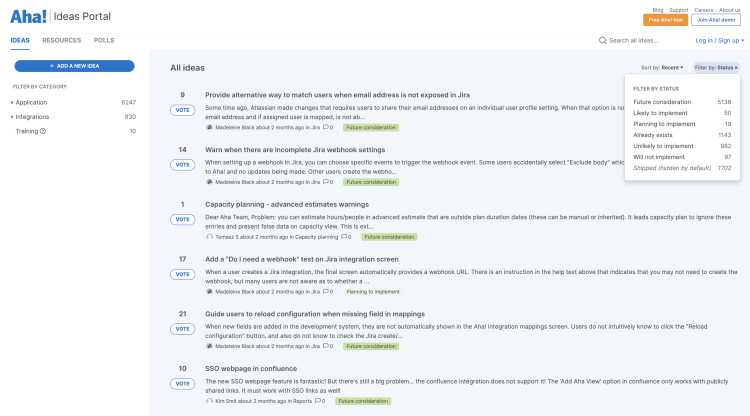
A Big Customer Wants to See Your Roadmap — Now What?
Tell me if this has happened to you. A big customer asks about a product enhancement. You are thrilled to share that the team is working on a feature for the next release that gives the customer exactly what they need. Everyone is happy. But then the feature gets delayed. There is a myriad of reasons this might happen — shifts in priorities, rescoping the release, bugs in development. Only now the customer is bummed about the very thing they had been eagerly anticipating.
You want to delight your customers. But revealing too much of your roadmap can end up disappointing them at times.
Customers are rightly curious. After all, they are paying for your product and counting on you to make it even better. And it is only natural that you want to tell them what they can look forward to. You want to include them in your excitement for the features the entire product team has worked hard to plan for and may even be working to deliver.
But a well-meaning roadmap presentation could easily be taken as an inadvertent guarantee. You do not want to bind yourself to particular dates and deliverables — especially as the team still needs to define the scope. And it is even more complicated if you have a lot of big customers who want different things or a vision that is pulling you away from what one important customer is asking for. Many product managers feel this tension. The good news is that it is up to you.
You and the company get to decide what your roadmap sharing policy is. But it is important that you are transparent internally and externally with your decision.
It is also true that customers really do not care about the exact details of your plan. They tend to care more about the overall direction and whether or not you are going to deliver more value. So, if you do not want to share the roadmap you can still indicate to customers where you are going.
For instance, you can use a public ideas portal like we do to highlight upcoming priorities and give folks a place to share feedback. Visitors to the portal can quickly filter by status to get a sense of where we are headed. And it offers great two-way communication — customers have the opportunity to voice what matters to them by submitting or voting on ideas.
This works well if you serve a very large group of customers like we do and cannot commit to sharing the roadmap every time someone asks. It is an easy way for thousands of companies and hundreds of thousands of users to get a sense of what we are working on.

Anyone can filter ideas by status in the public Aha! ideas portal to see what we are planning to implement.
This approach, coupled with purposeful customer conversations, offers ample transparency in most scenarios. And yet you might want to make exceptions for certain customers or have a policy of widely presenting your roadmap to customers and key partners. If you lean that way, sharing your roadmap more broadly likely makes sense — and maybe you even want to just publish it for anyone to see.
If you answer "yes" to any of the below, publishing an external roadmap could make sense for you:
1. Do most customers want the same enhancements?
Customers often have similar wish lists. When you are planning to deliver a highly-requested enhancement, publishing your roadmap could work in your favor to stir up anticipation.
2. Do upcoming enhancements change how customers will use your product?
If upcoming features will fundamentally alter how customers use your product, a heads-up can be helpful. The same goes if you are retiring features or making end-of-life plans.
3. Are big-picture items on your roadmap well-defined?
Major themes or areas of focus should be laid out in advance. If you contain that work within initiatives in Aha! Roadmaps, you can build an external-facing view that highlights those strategic buckets without revealing all of the work within them.
4. Do you have a habit of delivering with an established release cadence?
Consider giving customers a preview of upcoming releases on a custom roadmap — while hiding the exact delivery dates. This can build trust even if the exact dates will change.
However, if you answer "no" to the next few questions, it may be wiser to skip the customer-facing roadmap:
1. Are you worried about IP or confidentiality?
Maybe this is obvious — if you share your roadmap, people will see it. They might share it. So if you do not want customers or competitors to get wind of what you are working on next, find another way to drum up excitement for what is to come.
2. Do you have a plan for maintaining multiple roadmap views?
At the very least, you will need one separate customer-facing roadmap — but you will likely want to show different information to different types of customers. Static spreadsheets will trip you up here. Even if you use a roadmapping tool you need a plan for building, storing, and archiving roadmap versions.
3. Is the team ready to regularly present the roadmap or answer questions about it?
Great roadmap presentations require planning. You have to decide who will present, how you will invite customers, and how to handle follow-up questions. Getting these details right is one facet of providing a Complete Product Experience (CPE) to your customers.
Be purposeful in your approach and dole out sneak peeks in the manner that best fits your vision and how your team works. Remember, you are in control of this decision.
If you can make the case for publishing or regularly presenting a customer-facing roadmap after reviewing the criteria above, then dare to deliver an inspirational roadmap that you can commit to. Try rolling out your customer roadmap as an asset for your support team or in one-on-one calls with key customers first to make sure the story resonates. And if you want some helpful tips for building that roadmap in Aha! software, we have a guide for that too.
Read next: How to communicate your product roadmap to customers.
Roadmap everything. Start your Aha! software trial — free for 30 days.




